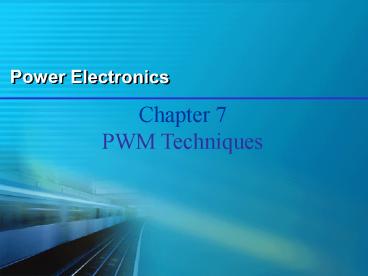Power Semiconductor Devices PowerPoint PPT Presentation
1 / 38
Title: Power Semiconductor Devices
1
Power Electronics
Chapter 7 PWM Techniques
2
The most widely used control technique in power
electronics
AC/AC
DC/DC
Pulse Width Modulation (PWM) (Chopping control)
AC/DC
DC/AC
3
Outline
7.1 Basic principles 7.2 Some major PWM
techniques in DC/AC inverters 7.3 PWM techniques
with feedback control 7.4 PWM rectifiers
4
7.1 Basic principles of PWM
Similar response to different shape of impulse
input
The equal-area theoremResponses tend to be
identical when input signals have same area and
time durations of input impulses become very
small.
5
Basic principles of PWM
Application of the equal-area theorem
- This is sinusoidal
- PWM (SPWM)
- The equal-area theorem can be applied
- to realize any shape of
- waveforms
6
A list of PWM techniques
- Triangular-wave sampling
- Natural sampling
- Uniform sampling
- Calculation
- Calculation based on equal-area criterion
- Selective harmonics elimination
- Hysteretic control
- Space Vector Modulation (SVM, or SVPWM)
- Random PWM
7
7.2 Some major PWM techniques
- Natural sampling
- Uniform sampling
- Selective harmonics elimination
- Some practical issues
- Synchronous modulation and asynchronous
modulation - Harmonics in the PWM inverter output voltages
- Ways to improve DC input voltage utilization and
reduce switching frequency - Connection of multiple PWM inverters
8
Triangular-wave natural sampling
Uni-polar PWM in single-phase VSI
- Uni-polar sampling is used to realize
uni-polar PWM.
9
Triangular-wave natural sampling
Bi-polar PWM in single-phase VSI
- Bi-polar sampling is used to realize
bi-polar PWM.
10
Triangular-wave natural sampling
In 3-phase VSI
- Three-phase bridge inverter can only realize
bi-bolar PWM therefore should be controlled by
bipolar sampling.
11
Triangular-wave uniform sampling
- Easier to realize by computer-control
- Modulation factor
12
Selective harmonics elimination PWM (SHEPWM)
13
Frequency relationship between triangular-wave
carrier and control signal
- Asynchronous Modulation
- Synchronous Modulation
14
Harmonics in the PWM inverter output voltages
Spectrum of 1-phasebridge PWM inverteroutput
voltage
- No lower order harmonics
- The lowest frequency harmonics is wc and adjacent
harmonics. wc has the highest harmonic content.
15
Harmonics in the PWM inverter output voltages
Spectrum of 3-phase bridge PWM inverter output
voltage
- No lower order harmonics
- No harmonics at wc. The lowest frequency and
highest content harmonics are wc?2wr and 2wc?wr.
16
Ways to improve utilization of DC input voltage
and reduce switching frequency
- Use trapezoidal waveform as modulating signal
instead of sinusoidal
17
Ways to improve utilization of DC input voltage
and reduce switching frequency
- Use 3k order harmonics bias in the modulating
signal
18
Connection of multiple PWM inverters
- Purposes
- Expand output power rating
- Reduce harmonics
19
Space Vector PWM (SVPWM or SVM)
Vector Space of 3-phase Line-to-Line Variables
- Phase variables (a, b and c) produce
- line-to-line variables (ab, bc and ca) in plane-?
- Line-to-line variables (ab, bc and ca) do not
have - ?-component in ???-coordinate system
20
Line-to-Line Voltage Space Vector
where
- Space vector
?
bc
v?
?
ab ?
?
v?
If Vm is the amplitude of balanced, symmetrical,
three-phase line-to-line voltages, then
ca
21
Switching States for 3-phase Voltage Source
Inverter
22
Switching State Vector pnn
?
bc
v?
?
?
ab, ?
v?
ca
23
Switching State Vector ppn
?
bc
v?
?
?
ab, ?
ca
24
Switching State Vector ppp
?
bc
ab, ?
ca
25
Switching State Vectors
26
Reference Voltage Vector, Vref
27
Definition of High Frequency Synthesis
?
For example
v?
V1(?)
V2(?)
Vref (?)
t
T1
T2
T0
TS
Total area of
Area of
28
Synthesis of Vref using Switching State Vectors
29
Duty Ratio of Switching State Vectors in SVPWM
From HF synthesis definition,
Assume is constant in TS ,
where
?
?
30
7.3 PWM techniques with feedback control
- Current hysteretic control
- Voltage hysteretic control
- Triangular-wave comparison (sampling) with
feedback control
31
Current hysteretic control
In Single-phase VSI
32
Current hysteretic control
In 3-phase VSI
33
Voltage hysteretic control
34
Triangular-wave comparison (sampling) with
feedback control
35
7.4 PWM rectifiers
Operation Principles
36
PWM rectifiers
Three-phase circuit
37
PWM rectifiers
Indirect current control
38
PWM rectifiers
Direct current control

